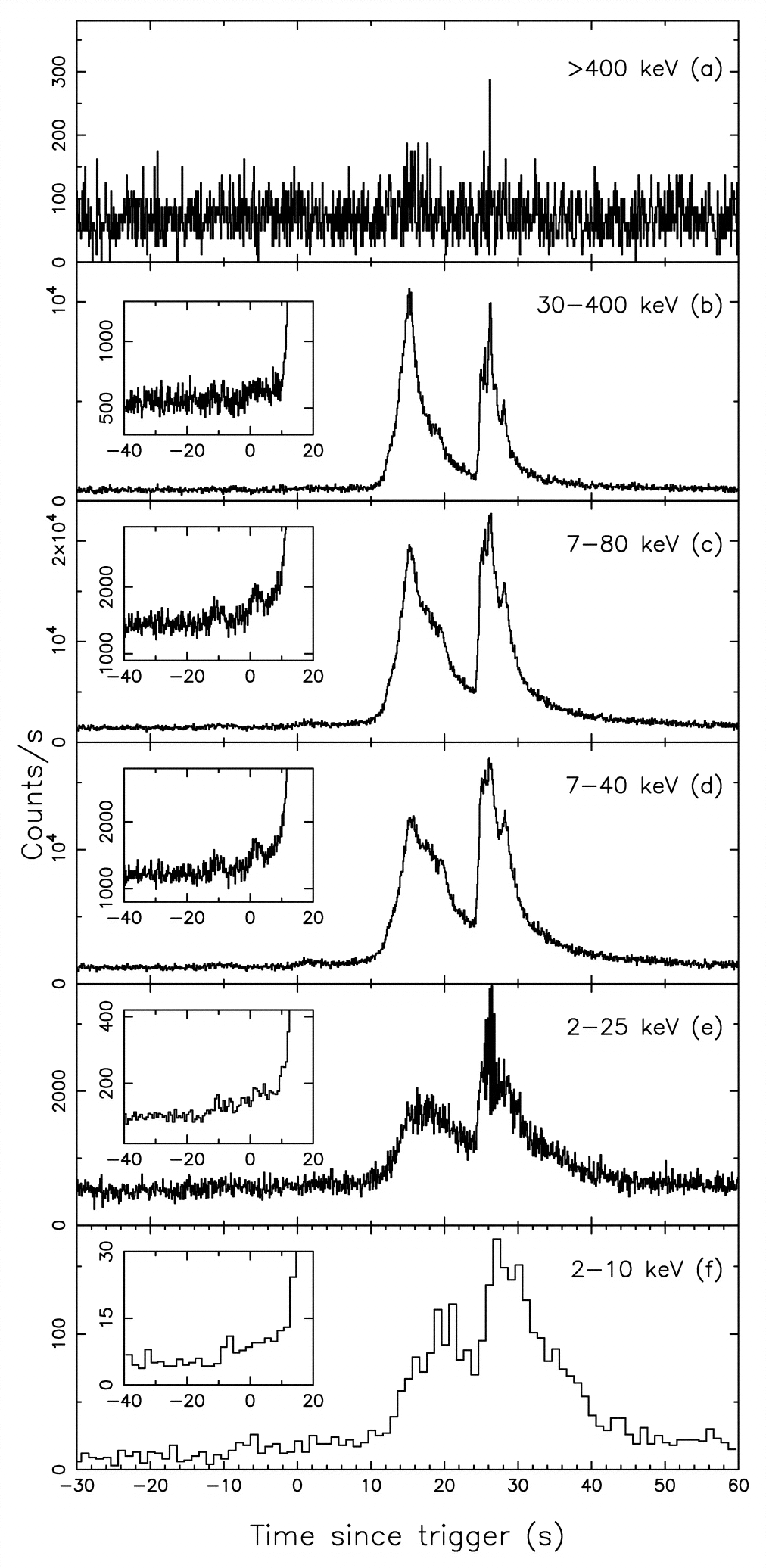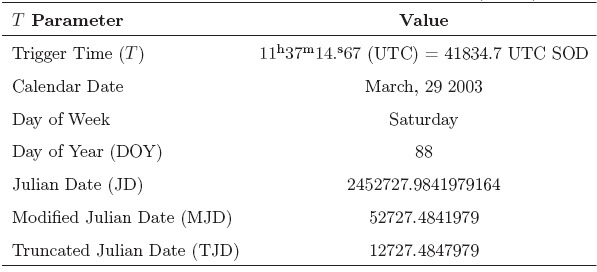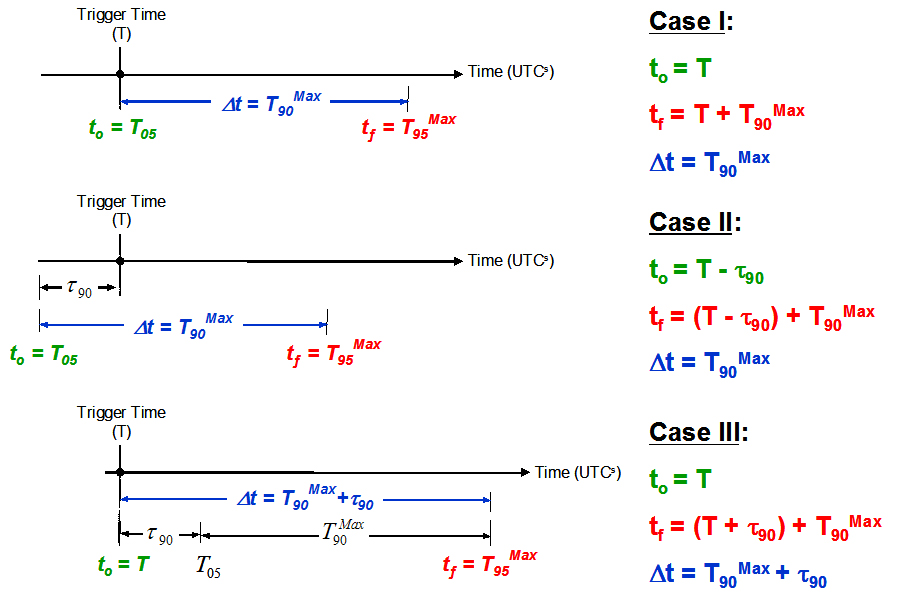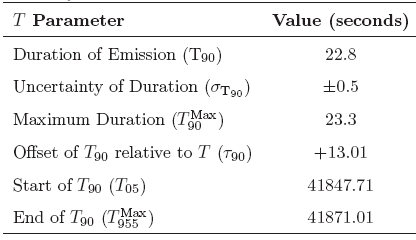
2. ELECTROMAGNETIC OBSERVATIONS
2.3 PROMPT g-RAY EMISSION
2.3.1 TEMPORAL PHOTON SPECTRUM (LIGHT CURVE)
On March 29, 2003, at 11h37m4.s67 (UTC), GRB030329 (H2652) triggered HETE-II (Vanderspek et al. 2003). The duration of the burst, canonically defined as the T90 interval, was 22.8±0.5 seconds in the 30-400 keV band pass (Vanderspek et al. 2004). The offset of the start of the T90 interval with respect to the trigger time (T), known as the T90 start time (t90), was +13.01 seconds (private communication, R. Vanderspek 2004), i.e. the T90 interval began 13.01 seconds after the trigger time, T. In addition, there appears to be activity at ~4 seconds prior to T (Vanderspek et al. 2004) as can be seen in plate b of figure 2.3.1.1.

FIGURE 2.3.1.1: Temporal spectra of GRB030329 for various energy bands, with insets illustrating precursor activity (Vanderspek et al. 2004). Light curves a-d are taken from FREGATE and have a time resolution of 80 ms (160 ms within the insets). Light curves e and f are from WXM and SXC, with time resolutions of 80 ms (640 ms within the inset) and 1 s (2 s within the inset), respectively. Note the delay between the trigger time and the arrival of the first pulse. This offset, known as the T90 start time, must be taken into account by coincidence searches.
In order to facilitate a discussion regarding the construction of the search window, we define the following canonical temporal variables associated with prompt g-ray emission:
Trigger Time (T) ≡ The time (UTCs) at which the satellite detector triggered. The trigger time may be converted into seconds of day (SOD) as follows:

Online tools are available for the above calculation (BATSE 2002). In addition to T, a calendar date (e.g. Saturday, March, 29, 2003) or a day number (d) of a given year is required. A more compact temporal identification may be found in the Julian Date (JD), which is defined as the decimal days since $12^{h}$ (noon) January, 1, 4713 BC. A precision in JD to the nearest thousandth (5 decimal places) ensures an accuracy in trigger time to the nearest second. The reference epoch J2000.0 refers to mean equator and dynamical equinox of Julian Date 2451545.0 (see Spatial localization) and can be generalized as follows:

It should be noted that equation above is specific for 2003. However, there are several algorithms available that calculate JD, as well as online calculators. Variants on the JD method exist which include the Modified Julian Date (MJD), determined from midnight (0h UTC) November 17, 1858, and Truncated Julian Date (TJD), determined from midnight (0h UTC) May 24, 1968; defined as follows:

For GRB030329, the above are summarized in table 2.3.1.1:
TABLE 2.3.1.1: Summary of Trigger Time Data Associated with GRB030329 (H2652).

Duration of Emission (T90) ≡ Canonical prompt g-ray emission duration (Koshut et al.1996); time (SIs) required to accumulate from 5% to 95% of the total counts above background.
sT90 ≡ The uncertainty (±SIs) in the T90 value.
T90Max ≡ T90 + sT90 ≡ Maximum GRB duration (SIs).
t90 ≡ Offset of T90 interval (±SIs), relative to trigger time (T).
T05 ≡ T + t90 ≡ UTCs start time of T90 interval; time of 5% accumulation of total counts.
T95Max ≡ T05 + T90Max ≡ Maximum UTCs end time of T90 interval; time of 95% accumulation of total counts.
Since the sign of t90 can be negative or positive, three distinct possibilities exist, as illustrated in figure 2.3.1.2.

FIGURE 2.3.1.2: Various possible cases of search window intervals, based upon the sign and value of t90. For GRB030329, case II applies.
For GRB030329, the relevant emission data are summarized in table 2.3.1.2.
TABLE 2.3.1.2: Summary of Emission Duration Data Associated with GRB030329 (H2652).
